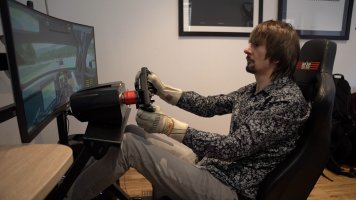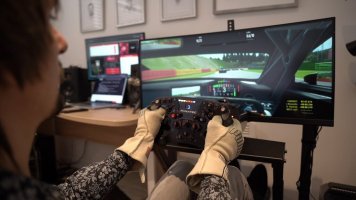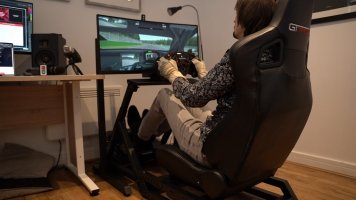RaceDepartment recently had the opportunity to test out the Next Level Racing GT Track, and here are our thoughts on the flagship cockpit from the Australian hardware manufacturer.
- Next Level Racing GT Track modular cockpit design.
- Suitable for direct drive wheels.
- Adjustable and expandable to include motion.
Sim racing cockpits, just like the people who sit inside them, come in all different shapes and sizes nowadays, making trying to find the ideal solution for you ever more difficult when navigating through the many available choices within the marketplace today.
In a time when new brands are seemingly popping up on a daily basis, Australia's Next Level Racing remain firmly towards the top of the tree in terms of both output and popularity. Founded in 2009, the following years have seen the company carve out a solid reputation within the sim racing landscape, leaving us excited to try out the Next Level Racing GT Track - a cockpit the developers consider to be their premium sim racing offering.
Key Features
- Designed for professional and serious sim racers.
- Pre-drilled for major brands.
- Adjustable on seat, wheel deck and pedal deck.
- Suitable for direct drive wheels and professional pedals.
- Expandable to include the NLR Motion Platform V3 and Traction Plus Platform.
- Features gear shift and handbrake support, Buttkicker adapter, racing harness, lockable wheels and feet.
During our test we used the Fanatec CSL Elite wheel and pedal set on the cockpit and experienced almost zero flex. As can be seen in the video review at the top of this article, Mike over at Simracing604 has an Accuforce Direct Drive wheel and Heusinkveld Sim Pedals sprint attached to the cockpit without any concerns for putting the rig under undue stress or flex. As sim racing peripherals continue to evolve, rigidity is something that more and more sim racers are looking for in their cockpit choices, often leading to a switch down the aluminium profile route, however from Mike's comments and my own time within the rig, I'm highly confident the ability to withstand high forces from top end sim racing hardware won't be a problem for this cockpit.
In terms of compatibility, we were pleased to find the cockpit already comes pre-drilled for a number of popular hardware brands straight out of the box. With support for Fanatec, Thrustmaster and Logitech to name but a few already immediately able to bolt onto the cockpit, we also really liked the touch by Next Level Racing to include mounting options for tactile immersion, with Buttkicker mounting brackets included in the design via a neat adapter than can be placed wherever feels most appropriate to the user - as someone that very briefly dabbled with and quickly gave up on mounting Buttkickers to my own cockpit, I think this aspect of the product will be very well-received by the sim racing community.
Another nice touch that is worth mentioning in this review is the inclusion of lockable caster wheels that can be screwed into the rig in place of standard static feet (both options included in the box). Weighing in at around XXXX including the seat, having caster wheels is a great option to allow gamers to easily move the cockpit around, but still have the ability to lock the wheels in place to produce a firm and solid base when stationary - a feature often overlooked by other brands and something that can, depending on one's requirements, really go a long way to making ownership of this particular rig much more user-friendly.
Forever a sceptic on these things, I paid particular attention to how firmly the rig would stay in place with the wheels in a locked position, and I can safely report that even on a wooden floor the cockpit didn't show any undue signs of potential slippage from the wheels - as such, I cannot foresee any issues with this design for users who wish to have the option of easily repositioning their rigs going forward.
To move away from the cockpit itself for a moment, another point worth noting is that Next Level Racing have designed the GT Track to allow owners the opportunity to add motion to their rig further down the line. Supporting the addition of the Next Level Racing Motion Platform V3 and Traction Plus platforms, the cockpit can easily accommodate the addition of these modules without the need to perform any additional adjustments to the rig itself - making this an ideal option for sim racers who are interested in upgrading to a motion platform style solution in future, but don't have the desire to build and install their own aftermarket solution and tweak the cockpit to accommodate these new bits.
Of course, this option only applies to Next Level Racing branded motion systems, so you are locked into that particular brand and style, but the design decision very much fits into the ethos of 'straight out the box' that is so prominent with this hardware - removing the need to spend time working out how to make everything work, allowing owners to simply get in and start enjoying their new gear.
AT 6 foot 5 tall I often find myself looking for space within, well, within anything really, so size is another aspect of the rig that I was keen to check out for myself as overall the floor space needed for this cockpit is similar to my Sim-Lab P1 aluminium profile rig, but without the benefits of personalization that comes with aluminium setups. Although the rig has been configured for my colleague, so wasn't perfectly tailored to my own preferences, I was delighted to find that space was certainly no issues at all, with plenty of room between my legs and the wheel deck, ample space on the seat, and a wide range of adjustability options across the board - from seat, wheel deck, pedals, I'm certain I could very easily get this rig to fit my requirements without any significant work required.
On the downside, and this is very much nitpicking rather than a serious negative, because the rig isn't aluminium profile it will naturally have less opportunity to really go to town with customization like I have become accustomed to with my own personal setup. This means that one will need to own a separate free-standing monitor stand (and the extra space this uses), and adding things like button boxes / wind simulators / other accessories will at best require third party mounting solutions, and at worst will require you to purchase the (admittedly wide range) of Next Level Racing accessories. As I say, not a negative as such, and it kind of ties into the whole plug and play philosophy of the rig, which will be seen as a firm advantage by some quarters of the sim racing community, but certainly worth mentioning in this text.
In summary, the Next Level Racing GT Track cockpit is a very well put together and robust piece of sim racing hardware, that offers a nice range of functionality and adjustability without ever quite reaching the highs of aluminium profile developed options. That said, while a perfectly sensible choice for someone looking to take their sim racing up a level, one very significant advantage held by the NLR GT Track is the plug and play expandability to incorporate motion solutions from Next Level Racing, ideal for sim racers who may wish to further expand their experience in future, but who don't necessarily have the skills / experience or desire to follow the DIY route of other options.
Overall, very nice and a more than solid option regardless of the hardware you plug onto the rig.



